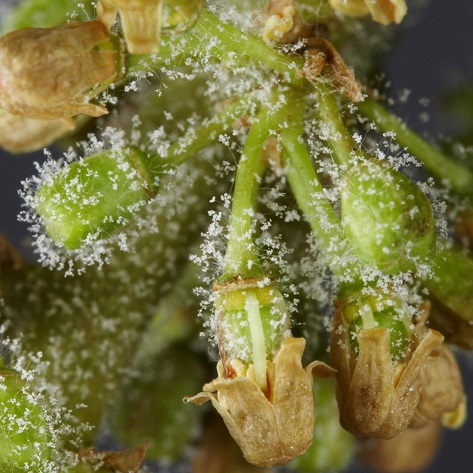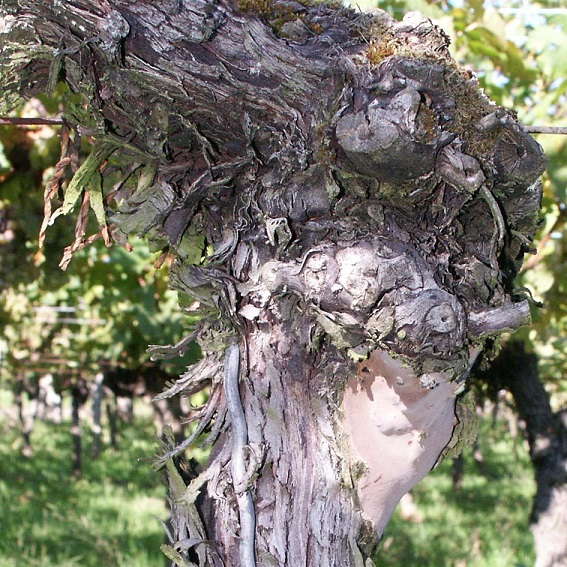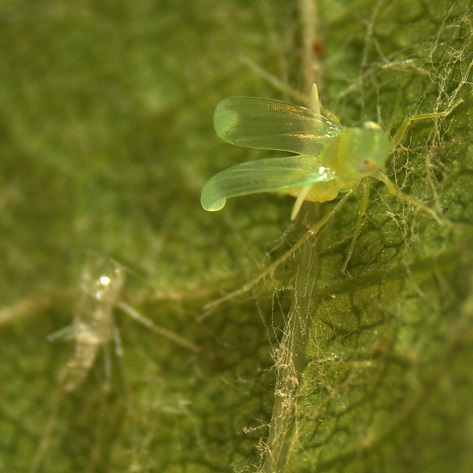‘Long dry periods may increase esca incidence and severity’Although people tend to use climate change and global warming interchangeably, global warming is just one aspect of climate change. Climate change is defined as changes in climate factors over a long period; including precipitation, temperature and atmospheric carbon dioxide (CO2) among others. These factors not only affect vine phenology (developmental stages in response to climate) but also its interaction with pathogens (eg. fungi) and pests (eg. insects).

As for fungal diseases, long wet periods may predispose vines to downy mildew (above) and bunch rot, while dry periods may predispose vines to powdery mildew and esca disease (below). As for insect pests, change in climate (mainly temperature) increases winter survival, number of generations per year and distribution range.

Researchers at Geisenheim University are looking into the future – investigating the effect of climate change on vines in many aspects (physiology, nutrition, vine health and wine quality). This is done in a project called FACE (Free Air Carbon-dioxide Enrichment), where vines are grown under elevated concentration of CO2 similar to that predicted in 2050.
As expected, under elevated CO2 a higher yield (number of berries) was observed due to increased photosynthesis, which altered bunch architecture (increased compactness) (Wohlfahrt et al, 2018). This may seem at first positive for vine growers but when it comes to vine health (eg fungal infections) one should reconsider this. In compact bunches berries often burst and their juice oozes out, which makes it ideal for rot fungi to grow.
'Vines grown under elevated CO2 are more susceptible to infection with downy mildew'Moreover, vines grown under elevated CO2 show more stomata, which could increase their susceptibility to infection with downy mildew, since the pathogen enters the vine through them. However, change in stomatal density is variety dependent. Another serious vine disease that is thought to be related to climate change is esca. Esca is one of the grapevine trunk diseases that is increasing in incidence and severity worldwide with average annual increase estimated to be 4-5%.
Esca has two forms:
- A chronic form that lasts for several years;
- An acute form (apoplexy) that kills the vine within a few days.
‘Increased temperature means more damage from insects’Rainy summers were found to favour chronic symptoms, while dry summers and hot winds were found to favour the acute form. Indeed, future predictions show that precipitation patterns will change (favouring long dry periods), which may increase esca incidence and severity.
Environmental factors, especially temperature, also play an important role in the development of insects. Increased temperature leads to shorter generation time and hence more generations per year and, in most cases, more damage. European grapevine moth (EGM) is a multivoltine insect (having multiple generations per year) from two to four generations depending on weather conditions. EGM is most important in southern Europe, where it has more generations per year and hence causes more damage. In northern Europe, EGM has normally two to three generations. However, in warmer years, a fourth generation can be observed, which indicates that future warm climate may increase EGM population and hence damage.
‘European grapevine moth and leafhoppers could increase their range northward’Another serious impact of climate change is insects’ range shift, where they can survive outside their current geographical ranges. According to some studies based on climate predictions for the year 2055, it was found that EGM will shift/increase its range up to approximately 500km northward. Another example of climate change impact on insect distribution is spotted wing drosophila (SWD). SWD is a relatively recent and destructive invasive pest species to the European soft-skinned fruit industry. Some regions, particularly in northern latitudes, may experience increased populations due to milder winters that increase their survival rate and ideal summer conditions that increase the number of generations and hence damage.

Pierce's disease (PD) is also a very serious grapevine disease. It is caused by a bacterium, which is spread by xylem feeding leafhoppers known as sharpshooters (similar to the green cicada above, but this one doesn’t vector any disease). The sharpshooters in question block the xylem which leads to scorching of leaves. Infected vines often die within one to five years. Insect vectors disperse the bacterium (while sucking on vine sap) from one plant/area to another. PD was once restricted to USA, however, since 2013 PD has caused serious damage to olive trees in southern Italy. PD is predicted to overcome the current boundaries outside Italy and spread across Europe if its vector extends its range.
Photos courtesy of HS Geisenheim. Geisenheim University's website has images of pests and diseases and their corresponding symptoms.













.png)






